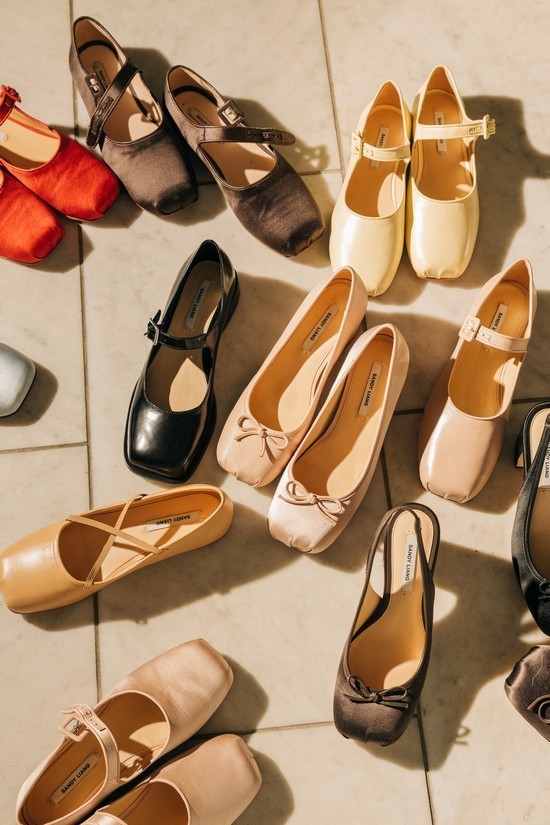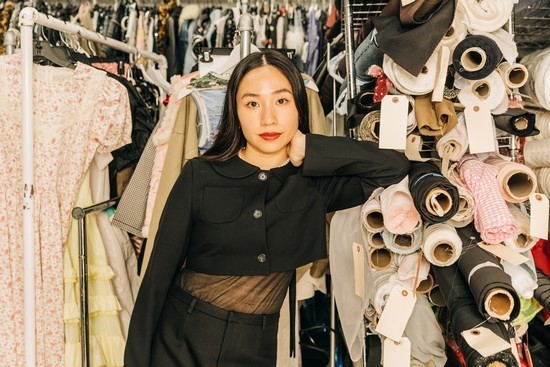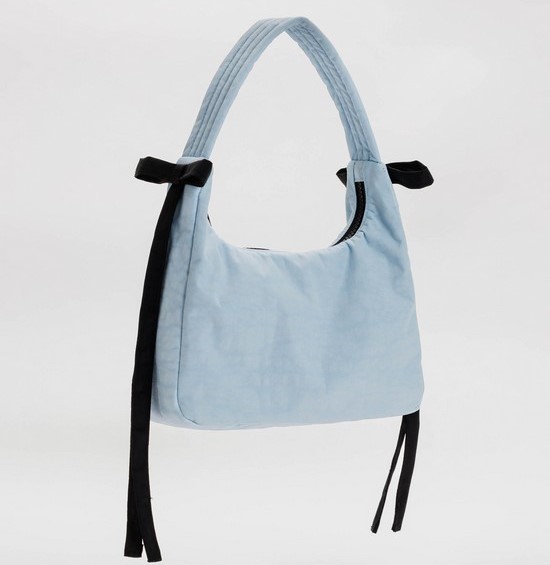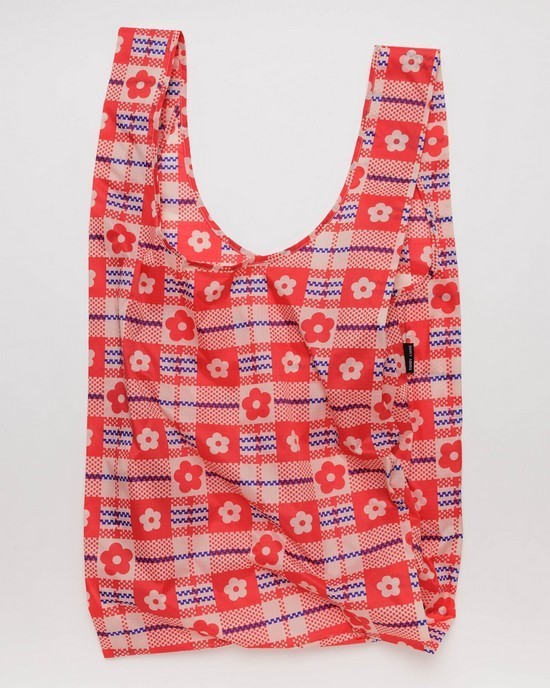Sandy Liang has long been attached to bows.
As a child she doodled them incessantly. Now she embeds them
incessantly into her line of clothing and accessories: on headbands and
pockets, on earrings and necklines, on the sides of socks and the slits of
skirts.
اضافة اعلان
Bows, Liang said, are a part of “this whole childhood emblem
thing,” along with other symbols — hearts, stars and flowers — that have since
become motifs in her designs.
Liang, 32, started her namesake brand in 2014, just after
graduating from the Parsons School of Design. By 2019, the label had its first
buzzy item: a playful, bold fleece that became something of a holy grail among
fashion insiders and was similarly inspired by her childhood wardrobe.
 Red and brown satin versions of the Mary Jane flat with a pointe toe
that Sandy Liang introduced in 2022, top left, with other shoes she has
designed, at her studio in New York, Aug. 7, 2023. Liang has brought her twist
on nostalgia to buzzy collaborations with companies including Vans, Target and
now Baggu.
Red and brown satin versions of the Mary Jane flat with a pointe toe
that Sandy Liang introduced in 2022, top left, with other shoes she has
designed, at her studio in New York, Aug. 7, 2023. Liang has brought her twist
on nostalgia to buzzy collaborations with companies including Vans, Target and
now Baggu.
In 2022, when Liang introduced her line’s first shoe, a Mary
Jane flat with a pointe toe that conjures after-school ballet lessons, the
initial inventory of about 800 pairs sold out in two days. Those flats, which
cost $495 and come in several colors, are still sought after by customers.
About 2,000 people have joined a waiting list for restock updates, according to
the brand.
This spring, Google searches for Sandy Liang soared when the
designer released two technical sneakers in collaboration with Salomon. This
week, after the accessories brand Baggu released a new collaboration with
Liang, searches seemed to reach an all-time high.
One of the most anticipated pieces in the Baggu collection,
which went on sale Tuesday and quickly sold out online, was a $62 nylon
shoulder bag with thin bows on its sides. (Lately Liang prefers bows that look
like Western neckties, with flattened loops and extra long strands.) Before the
bag was even available for purchase, dozens of people shared their DIY versions
on TikTok.
 The designer Sandy Liang at her studio in New York, Aug. 7, 2023. Liang
works at a basement studio on the Lower East Side, blocks from her namesake
brand’s store in the neighborhood.
The designer Sandy Liang at her studio in New York, Aug. 7, 2023. Liang
works at a basement studio on the Lower East Side, blocks from her namesake
brand’s store in the neighborhood.
Dozens of people also recently helped to spread a meme on
the app by sharing their interpretations of how to dress like a Sandy Liang
model. The posts featured a voice-over offering these instructions: “First, put
on a really, really tiny top. Then put on a pleated skirt, some knee-high
socks, hiking shoes — preferably Salomons. Put your hair up into braids or
space buns or pigtails. Add some dad sunglasses and bows everywhere. That’s
it.”
The Sandy Liang girl
That meme was created by Vivian Li, a doctoral student in
neuroscience and a fashion-oriented content creator in New York.
Li, 25, said she discovered Sandy Liang an old-fashioned way
— by walking past her store, which opened in December 2020 on the Lower East
Side of Manhattan. After posting photos of herself on Instagram wearing some
pieces she had bought, she began to receive free products from Liang’s team.
Li said she was drawn to the brand because its pieces mixed
pragmatism (a miniskirt with built-in shorts) and whimsy (a giant pink
scrunchie shaped like a flower).
“It’s not really dressing for anyone else’s gaze,” Li said
of the Sandy Liang aesthetic, which she added is prevalent among “Lower East
Side girlies.” (A meme about how people dress on the Lower East Side, Li said,
inspired hers about dressing like a Sandy Liang model.)
Emily Sugihara, the founder and CEO of Baggu, said that she
had wanted to work with Liang because she enjoyed how the designer explored the
tension between “functional sporty” and “theatrical girlie” in her pieces.
“I’m wearing the dresses. I’m wearing the shoes. I’m wearing
the funny schoolgirl uniforms, which I’m too old to wear, but it’s not stopping
me,” Sugihara said.
Liang, who grew up in Queens, is part of a tradition of
female designers subverting ultrafeminine clothes. Anna Sui, who made baby-doll
dresses grungy in the 1990s, said her clothes’ “girliness” — a quality she has
also seen in Liang’s work — is why “so many women have identified with what I
do.”
 In an undated image provided via Baggu, a nylon shoulder bag from Sandy
Liang’s collection with Baggu. Liang has brought her twist on nostalgia to
buzzy collaborations with companies including Vans, Target and now Baggu.
In an undated image provided via Baggu, a nylon shoulder bag from Sandy
Liang’s collection with Baggu. Liang has brought her twist on nostalgia to
buzzy collaborations with companies including Vans, Target and now Baggu.
Michelle Zauner, the writer-musician who performs as
Japanese Breakfast, was introduced by her stylist to Sandy Liang. Zauner said
the brand’s pieces, such as a white eyelet dress, have helped her to embrace a
more feminine personal style — particularly onstage, where she once felt
pressure to dress in a way that would make people take her seriously. “I’m a
Sandy girl,” she said.
Because of the brand’s nostalgic sensibility, Zauner said
that she felt uniquely connected to its designer, too. She mentioned following
Liang on Instagram and “seeing her in Japan at the Sanrio Cafe, and remembering
having Sanrio wallets, and wondering how those references are going to pop up
in her clothes.”
Zauner is not alone in her interest in Liang’s lifestyle and
influences.
This year, after Liang got married to architect Dorian
Booth, fans analyzed her wedding details, including her bouquet — a single
white allium tied with a black bow — and the schoolgirl outfits worn by
waitstaff, on social media and in newsletters. New York Magazine’s Strategist
website published an article about the black Merrell slides she wore with her
white dress.
The blurring between Sandy Liang, the brand, and Sandy
Liang, the person, is partially by design. Liang sells only clothing that she’d
wear, she said. She doesn’t imagine a girl in her head while designing; she is
the girl.
Sandy Liang, the girl
On a recent visit to Liang’s basement studio, a block of
text pinned to a mood board read: “She’s wearing her mom’s old lace dress with
grippy sport sandals from TJ Maxx, on her way to collect bugs and rocks with
shell phones in her ears.” (By which Liang meant nonfunctional earbuds shaped
like shells.)
Dean DiCriscio, a designer-stylist who has worked with Liang
since 2021, helps invent these story lines. “The references are not always
traditional,” he said.
Elsewhere on the board, which was made for her upcoming
runway show in September, a note read: “Pretty and fast but DARK.”
Darkness may seem like a surprising influence for a designer
whose brand sells a “magic wand belly ring” and a line of wedding dresses named
after princesses both real (Diana) and fictional (Peach, Mononoke). But the
childhood nostalgia underlying Liang’s work can also bum her out, she said.
“I’m obsessed over something that I can actually never
return to,” Liang said while facing a rack of samples at her studio. She was
wearing a white Peter Pan-collar blouse and a long black skirt, with a black
bow in her braided hair, a gold heart around her neck and silver stars in her
ears.
“I’ll have a memory of the way my best friend’s house
smelled growing up, or the shampoo that we used during a sleepover,” she said.
“I’ll smell it in my head, and then I’ll get really sad and yearn for it.”
Liang said she had tried to protect her “precious childhood
naivete.” But at some point, the kind of fantasies she’d dream up while drawing
in her older brother’s marble composition notebooks started to get bogged down
by practical concerns.
As she put it, “It’s like me wanting to design a crazy
runway look, but I’m hampered by: ‘No one’s going to buy this,’ and ‘What if
people hate it?’”
Her practical side comes in part from her father, a Chinese
immigrant and an entrepreneur. He owns the Congee Village restaurants in New
York and previously had a construction company. Liang said he had taught her
the importance of working for oneself.
 A tote bag with a red floral plaid print from Sandy Liang’s collection
with Baggu. Liang has brought her twist on nostalgia to buzzy collaborations
with companies including Vans, Target and now Baggu.
A tote bag with a red floral plaid print from Sandy Liang’s collection
with Baggu. Liang has brought her twist on nostalgia to buzzy collaborations
with companies including Vans, Target and now Baggu.
“I’m not just designing and sketching all day,” said Liang,
who employs about 10 people at her studio. “I’m also just trying to make sure
this is a running office.”
Christine Park, a brand consultant of 25 years who works as
the business manager at Sandy Liang, described Liang as astute, noting that the
designer has prioritized staying within budgets and not overdeveloping
collections. She is particularly concerned about making things that will sell,
and has brought wider attention to her brand through collaborations with large
companies including Vans and Target.
The Vans partnership, which began in 2020, funded the
opening of her store, Liang said. Park declined to provide the monetary figures
of Liang’s collaboration deals but said that she had seen designers over the
years earn between $10,000 and $500,000, depending on the project’s scope.
When Liang’s two-shoe collaboration with Salomon was
released, both styles sold out at a rate that Bryan Diaz, a marketing
specialist at Salomon, said the outdoor sports company had never seen.
Posts on X, formerly known as Twitter, made before the
release of Liang’s collaboration with Baggu suggested a similarly ravenous
appetite. Liang is not on the platform — she said she stopped using it because
she would “only pay attention to the mean comments” — so I read aloud a couple
of the more histrionic takes while visiting her studio.
One: “If I don’t get something from the Baggu x Sandy Liang
drop, I’m going to do something so violent and catastrophic it will change the
course of history forever.”
Another: “Nobody understands how BIBLICALLY I need this
Sandy Liang x Baggu collab.”
Liang laughed and cringed. “It makes me so happy that I can
make someone even care that much,” she said.
Read more Fashion
Jordan News



